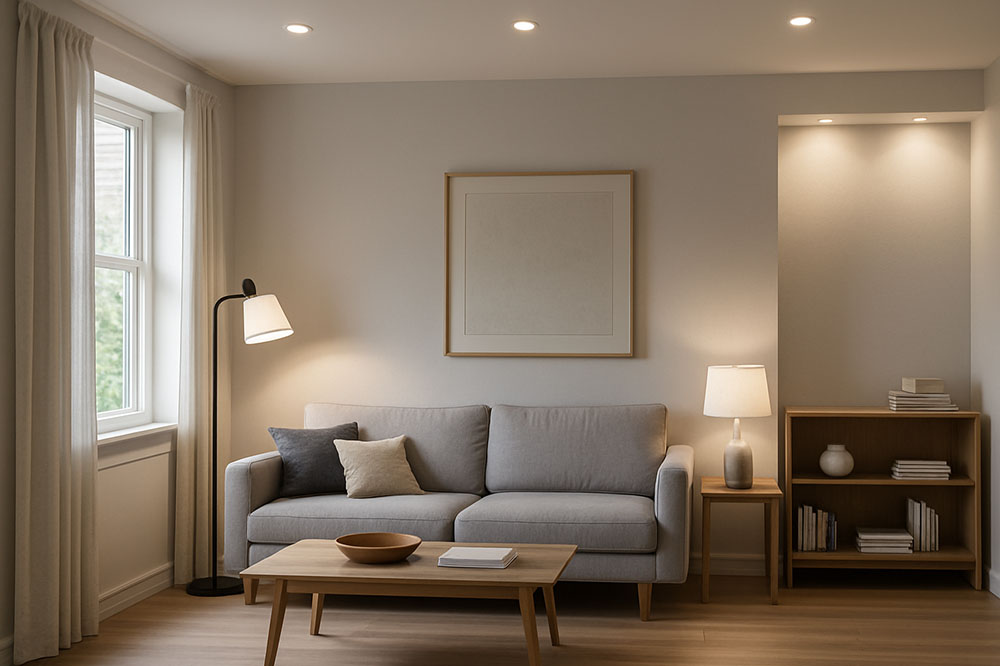How do you layer lighting to make a room both practical and inviting?
Ever walk into a room and feel like something is… off? The sofa looks fine, the paint colour works, the furniture is in place. But the space feels flat, cold, almost lifeless. Nine times out of ten, the culprit is lighting.
Lighting can make a room sing or make it feel like a waiting room at the dentist. And here’s the kicker: it’s not about buying the fanciest chandelier or splashing out on expensive designer lamps. It’s about layering. Get that right, and suddenly your living room feels cosy yet functional, your kitchen feels welcoming but efficient, and your bedroom becomes a calm retreat without being a cave. That’s what we’re diving into here, because honestly, who has time to guess?
The three core layers of lighting
Start with the basics. Every good room design uses three layers: ambient, task, and accent. Think of them as different players in the same band. One covers rhythm, another carries the melody, and the third adds flair.
- Ambient lighting is your baseline. If you’re looking for ambient lighting ideas, ceiling fixtures, recessed lights, or large pendants set the general brightness so you can move around safely. Without it, the room feels dim and awkward.
- Task lighting zooms in. Reading lamps by a chair, under-cabinet lights in the kitchen, a desk lamp where you work. These are the lights that actually help you do things.
- Accent lighting adds atmosphere. Some quick accent lighting tips include using a floor lamp that washes light up a wall, LED strips behind a bookcase, or a couple of small lamps that soften corners. These don’t just fill space, they add personality.
Miss one of these layers and your room ends up unbalanced. Rely only on ambient and you’ve got a bright but sterile space. Go heavy on accent lights without a good base and you’ll be squinting just to find your keys.
How the layers work together
I’ve lost count of the number of homes I’ve walked into where people installed one big ceiling light and called it a day. Functional? Barely. Inviting? Not at all.
Layering means letting each type of light play its part. Ambient keeps the whole room visible. Task lights give you precision where you need it. Accents soften everything, pulling it together and adding depth.
Here’s the magic: when they overlap, the room feels alive. You don’t consciously notice every bulb, but you feel the balance. You feel comfortable.
Ever wonder why designer showrooms or hotels feel so polished? It’s not the furniture alone. It’s that they rarely, if ever, rely on just one light source.
Step-by-step guide to layering lighting
Step 1: Assess the room’s purpose. A living room used for movie nights and reading needs a very different setup to a kitchen or a home office. Don’t skip this step. Lighting has to fit life, not just look good in photos.
Step 2: Start with ambient. This is the backbone. Overhead fixtures or recessed lights set the tone. If you want flexibility, go for dimmable options.
Step 3: Add task lighting. Think about where activities happen. Reading chair? Add a floor lamp. Kitchen counters? Under-cabinet strips. Desk? Adjustable desk lamp. Task lights are your workhorses.
Step 4: Bring in accent lighting. Once the basics are covered, layer in mood. Uplighters, wall sconces, small table lamps—these make the space inviting rather than purely functional.
Step 5: Control the balance. Dimmers or smart bulbs let you shift the mood without rewiring your home. Bright for cleaning, soft for evenings. Without control, even the best setup feels rigid.
Room by room examples
Living room. Start with a ceiling fixture or recessed lighting for the base. Add a floor lamp by the sofa for reading, and smaller lamps on side tables to soften corners.
Kitchen. Bright ambient lights on the ceiling, task strips under cabinets, and pendants above an island. The layers let you chop vegetables safely without making the whole kitchen feel like an operating theatre.
Bedroom. A soft ceiling fixture for general use. Lamps on each bedside for reading. Then, perhaps a warm LED strip tucked behind the headboard for a gentle glow that makes the whole room feel calm.
Home office. A bright desk lamp aimed at your workspace, a ceiling light that doesn’t cast harsh shadows, and maybe a small accent light behind you for video calls. Function meets comfort.
Bathroom. Bathroom lighting ideas usually start with bright ambient fixtures on the ceiling. Then add task lighting either side of the mirror (never just above, unless you like unflattering shadows). Then a softer accent light, such as a wall sconce or dimmable overhead, for relaxing baths.
Hallways and corridors. Often neglected, these areas benefit from layered lighting too. Ambient ceiling lights for safety, plus accent wall sconces or low-level LED strips along skirting boards to create atmosphere and guide the way at night.
Dining room. A statement pendant or chandelier provides ambient light and sets a focal point. Pair it with dimmers so you can lower the mood for dinner parties. Wall sconces or a sideboard lamp add warmth without overwhelming the table.
Advanced tricks for better lighting
- Layer light vertically. Don’t keep everything at ceiling height. Combine overhead lights with mid-level lamps and low-level lighting near the floor. This creates depth.
- Bounce light off surfaces. Aim uplighters toward ceilings or walls to reflect light back into the room. It makes spaces feel bigger and less harsh.
- Play with shadows. Accent lights don’t just brighten, they create contrast. A spotlight on a plant or a textured wall adds drama.
- Zone with light. Open-plan rooms benefit from different pools of light. A pendant above the dining area, a cluster of lamps by the sofa, under-cabinet strips in the kitchen zone, all in the same room.
- Think about colour temperature mixing. Warm light in living spaces, cooler light for tasks. Mixing them strategically creates subtle transitions that suit different activities.
- Automate. Smart lighting lets you set scenes—one button for ‘movie night’, another for ‘work mode’ with systems like Philips Hue or LIFX. It removes the hassle of fiddling with switches.
Ever noticed how your mood changes when the lights dim for a film? Or how working under harsh cold light can leave you drained? That’s the cause-and-effect of lighting done right. Or wrong.
Lighting isn’t decoration you add at the end. It’s part of how a room works. Get the layers right and your home shifts from functional to enjoyable without buying a single new sofa.
So here’s the takeaway: look around your space tonight. Does it have ambient, task, and accent lights, or are you leaning too hard on that single ceiling fixture? Try adding just one new layer this week and watch how the mood changes. Give it depth. Give it layers. Then sit back and feel the difference.




